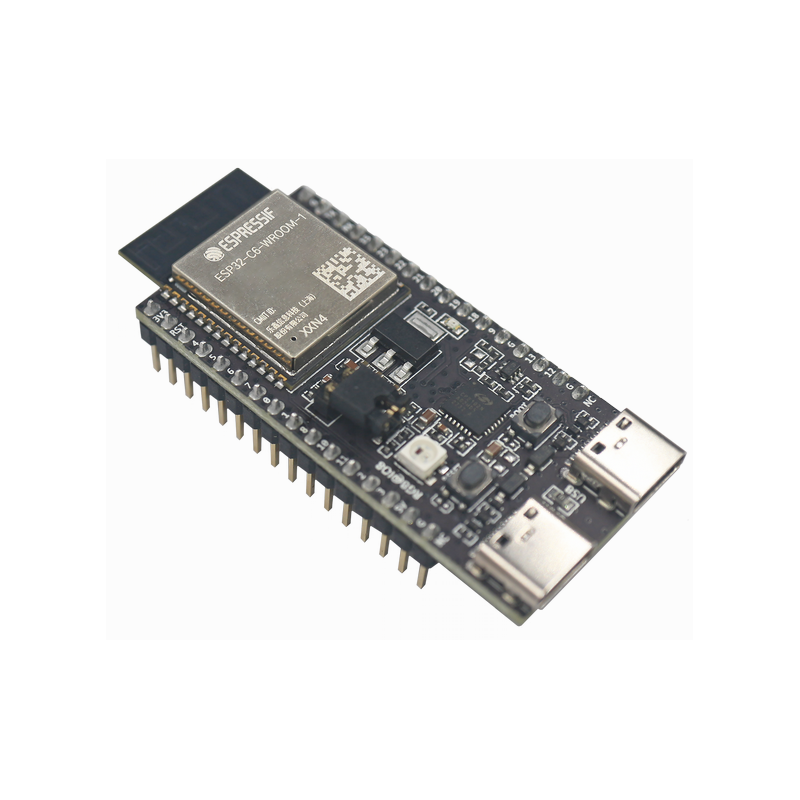





Stratix® 10 DX ESP32-C6-WROOM-1 Transceiver; 802.11 a/b/g/n (Wi-Fi, WiFi, WLAN), 802.15.4 (Thread, ZigBee®), Bluetooth® 5 2.4GHz Evaluation Board
| Espressif | |
| Product Category: | Multiprotocol Development Tools |
| Development Boards | |
| ESP32-C6-WROOM-1 | |
| USB | |
| Brand: | Espressif Systems |
| Product Type: | Multiprotocol Development Tools |
Getting Started: Overview of ESP32-C6-DevKitC-1 and hardware/software setup instructions to get started.
Hardware Reference: More detailed information about the ESP32-C6-DevKitC-1’s hardware.
Hardware Revision Details: Revision history, known issues, and links to user guides for previous versions (if any) of ESP32-C6-DevKitC-1.
Related Documents: Links to related documentation.
This section provides a brief introduction of ESP32-C6-DevKitC-1, instructions on how to do the initial hardware setup and how to flash firmware onto it.

ESP32-C6-DevKitC-1 - front
The key components of the board are described in a clockwise direction.
|
Key Component |
Description |
|---|---|
|
ESP32-C6-WROOM-1 or ESP32-C6-WROOM-1U |
ESP32-C6-WROOM-1 and ESP32-C6-WROOM-1U are general-purpose modules supporting Wi-Fi 6 in 2.4 GHz band, Bluetooth 5, and IEEE 802.15.4 (Zigbee 3.0 and Thread 1.3). They are built around the ESP32-C6 chip, and comes with a 8 MB SPI flash. ESP32-C6-WROOM-1 uses on-board PCB antenna, whereas ESP32-C6-WROOM-1U uses external antenna connector. For more information, see ESP32-C6-WROOM-1 Datasheet. |
|
Pin Header |
All available GPIO pins (except for the SPI bus for flash) are broken out to the pin headers on the board. |
|
5 V to 3.3 V LDO |
Power regulator that converts a 5 V supply into a 3.3 V output. |
|
3.3 V Power On LED |
Turns on when the USB power is connected to the board. |
|
USB-to-UART Bridge |
Single USB-to-UART bridge chip provides transfer rates up to 3 Mbps. |
|
ESP32-C6 USB Type-C Port |
The USB Type-C port on the ESP32-C6 chip compliant with USB 2.0 full speed. It is capable of up to 12 Mbps transfer speed (Note that this port does not support the faster 480 Mbps high-speed transfer mode). This port is used for power supply to the board, for flashing applications to the chip, for communication with the chip using USB protocols, as well as for JTAG debugging. |
|
Boot Button |
Download button. Holding down Boot and then pressing Reset initiates Firmware Download mode for downloading firmware through the serial port. |
|
Reset Button |
Press this button to restart the system. |
|
USB Type-C to UART Port |
Used for power supply to the board, for flashing applications to the chip, as well as the communication with the ESP32-C6 chip via the on-board USB-to-UART bridge. |
|
RGB LED |
Addressable RGB LED, driven by GPIO8. |
|
J5 |
Used for current measurement. See details in Section Current Measurement. |
You might also like